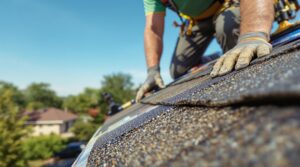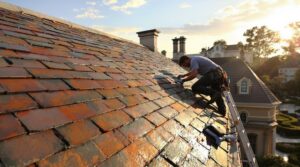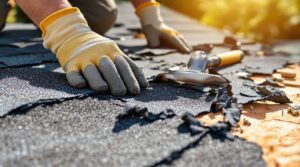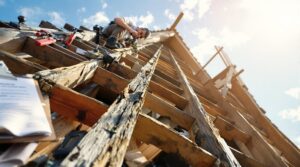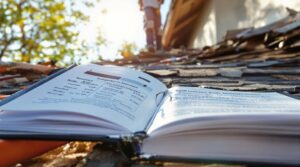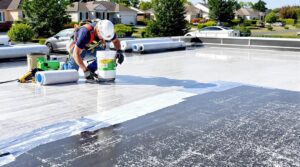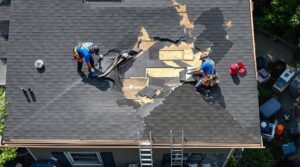Ever wondered what it takes to fix a rolled roof without breaking the bank? Let's dive into the world of rolled roofing, where repairs can be as simple as patching a small leak or as extensive as giving your roof a complete makeover.
Think of your rolled roof like a protective blanket – when it develops issues like pesky open seams or bubble-like blisters, it needs some TLC. These common problems, often caused by Mother Nature's mood swings, require specific repair techniques that'll keep your home snug and dry.
DIY warriors might get excited about the affordable material costs, typically running $1.50 to $2.00 per square foot. But before you climb that ladder, consider that professional repairs usually range from $150 for minor fixes to $2,000 for major overhauls. The final tab depends on your location, damage extent, and who's wielding the tools.
What about your wallet's best friend – home insurance? Here's the deal: keeping your rolled roof in tip-top shape isn't just about preventing leaks. Insurance companies love well-maintained roofs, and working with seasoned insurance adjusters can help you maximize claim settlements when unexpected damage occurs.
Want a pro tip? Regular maintenance isn't just a chore – it's your roof's insurance policy against bigger problems down the road. Plus, it might just help keep those insurance premiums from soaring through the (well-maintained) roof!
Key Takeaways
Wondering why your rolled roofing needs some TLC? Let's dive into everything you need to know about repairs, costs, and insurance – no fancy jargon required!
Think of rolled roofing repairs like patching up a leather jacket – it's all about finding those pesky openings and blisters. A typical repair job can set you back anywhere from $150 for minor fixes to $2,000 for more extensive work. Just like getting your car serviced regularly saves money in the long run, keeping an eye on your rolled roof through routine check-ups can prevent major headaches down the road.
Want to tackle some repairs yourself? The materials are surprisingly budget-friendly at $1.50-$2.00 per square foot – perfect for those low-slope or flat roofs that need some love. But here's the real game-changer: maintaining your rolled roof doesn't just protect your home; it can actually lower your insurance premiums!
Speaking of insurance, your rates will fluctuate based on three key factors: your roof's age (like fine wine, newer is often better), material durability (how tough is your roof against Mother Nature?), and your local weather patterns. If you're filing a claim, consider bringing in a public adjuster – these pros can boost your settlement by 20-40% through expert documentation and negotiation skills.
Remember: your roof is like an umbrella for your entire home – invest in its care, and it'll keep you covered for years to come!
Understanding Common Rolled Roofing Materials and Their Applications
Rolled roofing materials represent a cost-effective solution for low-slope and flat roof applications, consisting primarily of asphalt-integrated felt or fiberglass mats with bituminous coatings.
The primary variants include mineral-surfaced roll roofing, which provides enhanced UV protection, and plain roll roofing without granular coating. Modified bitumen options incorporate multiple layers for commercial applications.
Roll roofing comes in mineral-coated and plain varieties, with specialized multi-layer bitumen options designed for commercial needs.
Among rolled roofing benefits, cost-efficiency stands at $1.50 to $2.00 per square foot, with straightforward installation techniques suitable for DIY projects.
Common applications include outbuildings, temporary coverings, and structures with minimal pitch. TPO and PVC variants offer additional durability for commercial settings, though traditional rolled roofing typically demonstrates shorter longevity compared to conventional materials like metal or tile roofing systems. When filing an insurance claim for rolled roofing damage, weather impact assessments play a crucial role in determining coverage and processing timelines.
Essential Repair Techniques for Different Rolled Roofing Issues
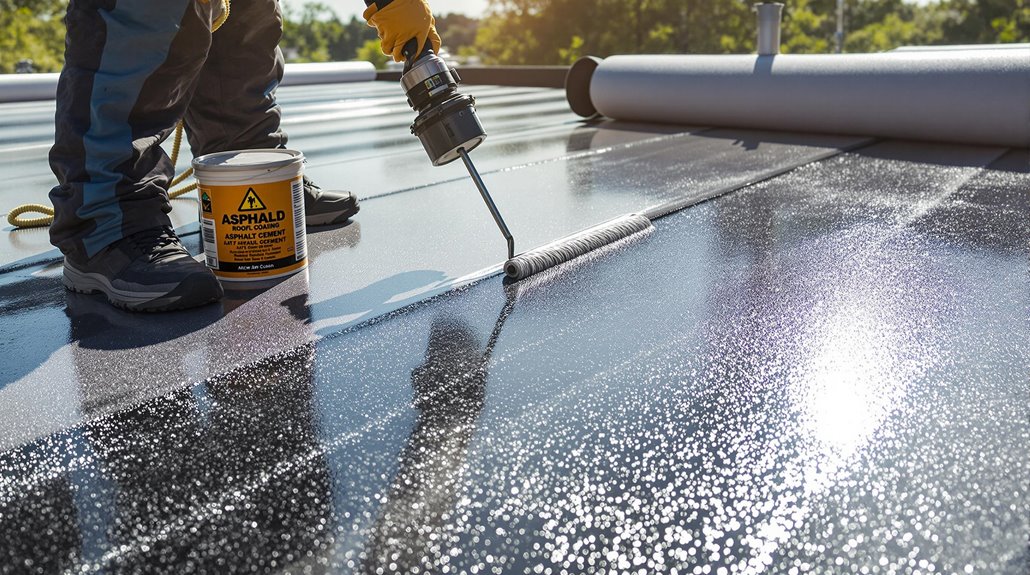
Addressing rolled roofing issues requires systematic repair techniques that vary based on the specific damage type and severity.
Initial leak detection involves thorough inspection of the surface, followed by removal of deteriorated materials using a cat's claw for nail extraction.
Common patching techniques include treating open joints with asphalt cement, replacing damaged sections with new felt, and addressing blisters by releasing trapped air.
Repairs typically involve cleaning the affected area, applying new material under existing layers, and securing edges to prevent water infiltration. For extensive damage, entire sections may require replacement.
Preventive measures encompass regular inspections, debris removal, and seal maintenance.
The application of protective coatings, such as solar reflective treatments or liquid coatings, helps extend the roofing system's lifespan and prevent future deterioration.
Professional inspections showing maintenance records are essential for successful insurance claims and coverage validation.
Breaking Down the Cost Factors of Rolled Roofing Repairs
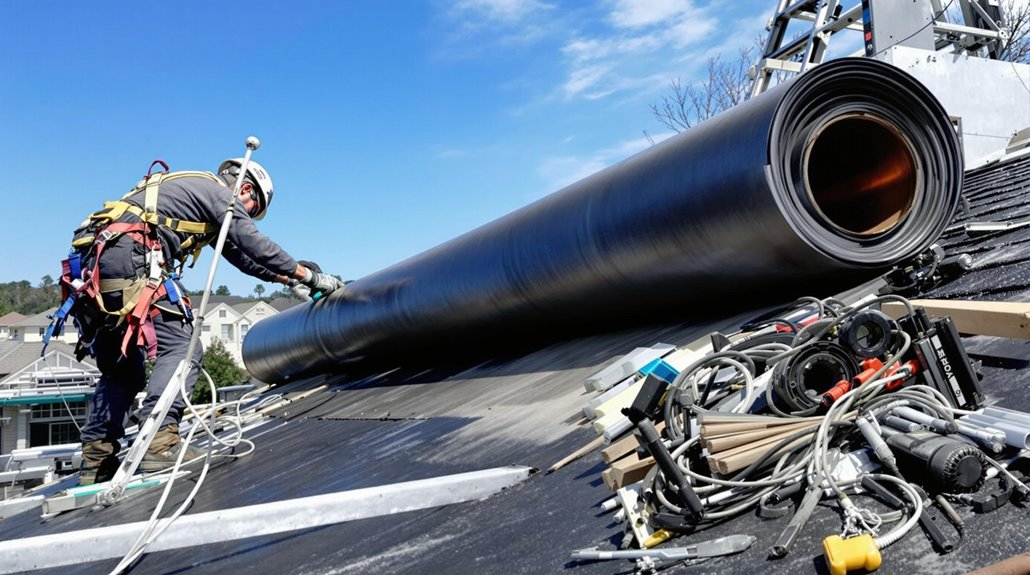
When evaluating rolled roofing repairs, contractors must analyze multiple cost variables that directly impact project pricing.
The cost breakdown typically includes material expenses, ranging from $150 for minor repairs to $2,000 for major replacements, alongside labor rates which vary by contractor expertise and location.
Repair estimates factor in damage severity, with small tears costing considerably less than structural issues requiring membrane replacement.
The extent of roofing damage determines repair costs, from simple tear fixes to complete membrane replacements.
Accessibility challenges, such as complex roof designs or difficult entry points, increase labor costs due to additional equipment and safety requirements.
Emergency repairs command premium pricing compared to scheduled maintenance work.
Climate conditions and regional market demands further influence final costs, while warranty coverage and insurance policies may offset certain expenses depending on damage cause and documentation.
Working with public adjusters can increase insurance claim settlements by 40-350% for qualified roofing repairs.
How Your Rolled Roof Affects Home Insurance Premiums
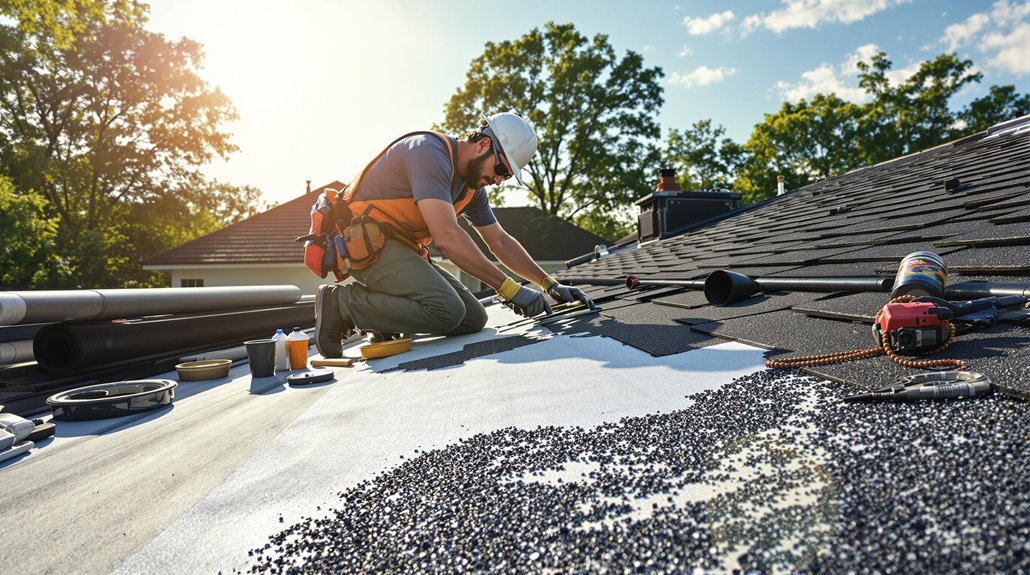
Insurance companies evaluate rolled roofing systems through multiple assessment criteria to determine premium rates for homeowners. Key factors include the roof's age, material durability, and current condition. Properties in regions prone to severe weather events typically face higher premiums due to increased risk exposure.
Homeowners can secure premium discounts through strategic improvements and maintenance. Installing impact-resistant materials, implementing fire-resistant features, and conducting regular professional inspections demonstrate risk mitigation to insurers.
Hip roof designs, which offer superior wind resistance, may qualify for additional rate reductions.
The long-term financial benefits of proper rolled roof maintenance extend beyond insurance savings, as well-maintained systems reduce the likelihood of costly repairs and minimize the frequency of claims submissions.
Regular maintenance and safety improvements can lead to premium discounts of 10-15% on homeowners insurance policies.
Maintenance Strategies to Minimize Insurance Costs and Extend Roof Life
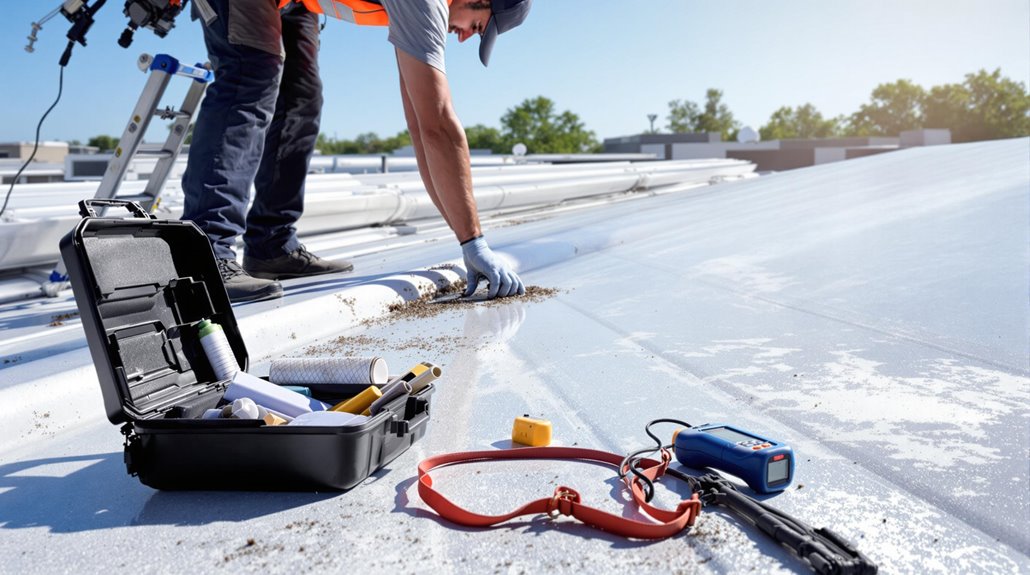
Maintaining a rolled roof through systematic inspection and preventive care protocols directly influences both insurance costs and system longevity.
Regular roof inspection schedules, particularly after severe weather events, enable early detection of potential issues and facilitate prompt repairs, maximizing cost efficiency over time.
Proactive roof inspections and timely repairs following storms protect your investment and prevent costly future damage.
Key maintenance activities include debris removal to prevent water pooling, seam integrity verification, and immediate repair of any identified damage.
These practices not only extend the roof's operational lifespan but can also result in reduced insurance premiums through documented maintenance records.
Insurance providers often offer rate reductions for properly maintained roofs, especially those featuring impact-resistant materials or enhanced waterproofing measures.
Additionally, professional consultation for complex repairs guarantees proper execution and helps prevent recurring issues, further optimizing long-term cost management.
Working with public claims adjusters can increase insurance settlements by up to 800% when filing claims for roof damage.
The Benefits Of Consulting A Public Adjuster For Roof Repairs
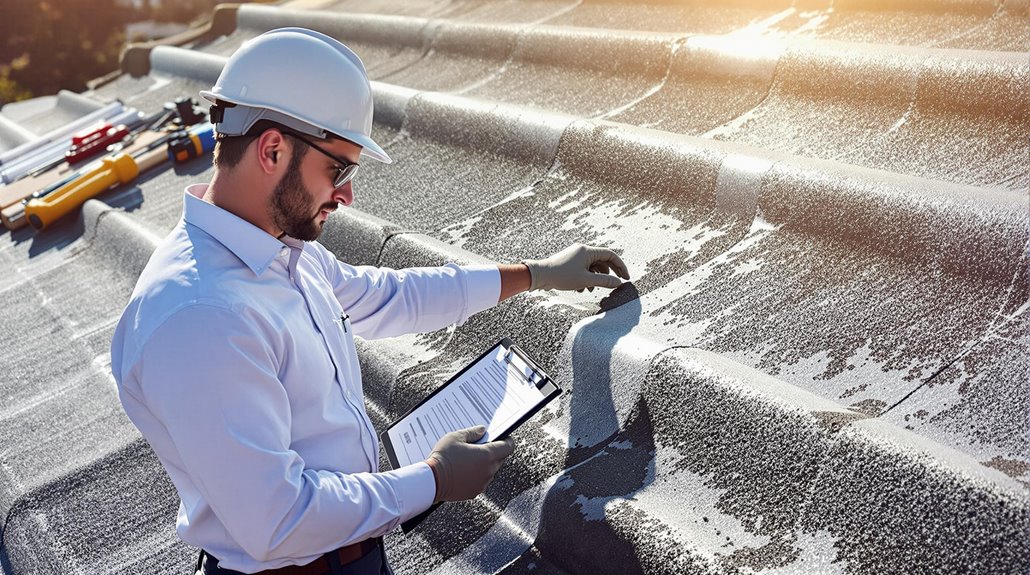
Public adjusters provide professional expertise in managing complex insurance claims for rolled roof repairs, offering objective damage assessments that often identify coverage-eligible issues overlooked during initial inspections.
Their thorough documentation and negotiation skills typically result in claim settlements 20-40% higher than those secured without professional representation.
Through established protocols and industry knowledge, public adjusters expedite the claims process while ensuring all damage-related costs, including materials and labor, are properly calculated and submitted for maximum insurance compensation.
Expertise In Insurance Claims
When homeowners face rolled roof damage, consulting a public adjuster can greatly improve their insurance claim outcomes. These professionals possess extensive knowledge of insurance policy nuances and employ proven claim interpretation strategies to maximize coverage benefits. Their expertise enables accurate assessment of damage scope and associated repair costs.
Public adjusters compile thorough documentation, including detailed photographs and precise repair estimates, to support claims. They manage all communication with insurance providers, ensuring timely responses and proper submission of evidence.
Their negotiation skills often result in higher settlement amounts compared to policyholder-managed claims. Studies demonstrate that professional adjusters' understanding of policy terms and market-rate repair costs consistently leads to more favorable outcomes, while reducing the homeowner's time investment and stress during the claims process.
Objective Damage Assessment
Professional damage assessment through a public adjuster delivers quantifiable advantages for rolled roof repair claims. Through systematic roof inspection and extensive damage reporting, adjusters provide evidence-based documentation that strengthens insurance claims and guarantees regulatory compliance.
Key benefits of professional assessment include:
- Detailed photographic and written documentation of visible and concealed damage patterns
- Precise measurements and cost calculations for repair estimates
- Verification of building code compliance requirements
- Expert analysis of structural integrity and safety concerns
This systematic approach facilitates accurate claim settlements while identifying potential issues that could lead to costly future repairs.
The adjuster's objective evaluation helps property owners secure appropriate compensation while maintaining proper documentation for insurance purposes. Their expertise in assessment protocols guarantees thorough damage identification and supports strategic maintenance planning.
Streamlined Claim Process
Maneuvering the complex terrain of insurance claims requires strategic expertise that public adjusters bring to rolled roof repair processes. These professionals streamline claim documentation through systematic approaches, utilizing specialized software and maintaining detailed records of all damage assessments and communications.
Public adjusters excel in insurance negotiation by leveraging their extensive knowledge of policy terms, coverage limitations, and building codes. They facilitate efficient communication between contractors, insurers, and property owners while preventing common delays through proactive measures.
Their expertise in identifying covered damages and understanding policy nuances enables them to secure appropriate compensation for repairs. By implementing temporary protective measures and conducting thorough inspections, they prevent secondary damages that could complicate claims, ultimately expediting the entire process from initial assessment to final settlement.
Higher Claim Payouts & Settlements
Securing ideal compensation for rolled roof repairs hinges significantly on the involvement of public adjusters, who statistically achieve 20-40% higher claim settlements compared to policyholder-managed claims.
Through strategic claim negotiation and thorough documentation, public adjusters leverage their expertise to maximize settlement values while ensuring all damage aspects are properly assessed and valued.
Key settlement strategies implemented by public adjusters include:
- Detailed cost analysis of materials and labor requirements
- Documentation of both visible and concealed damage patterns
- Assessment of long-term structural implications
- Integration of current market rates for materials and services
Their specialized knowledge of policy terms, combined with professional damage assessment capabilities, enables public adjusters to secure settlements that accurately reflect the full scope of necessary repairs and replacements for rolled roofing systems.
About The Public Claims Adjusters Network (PCAN)
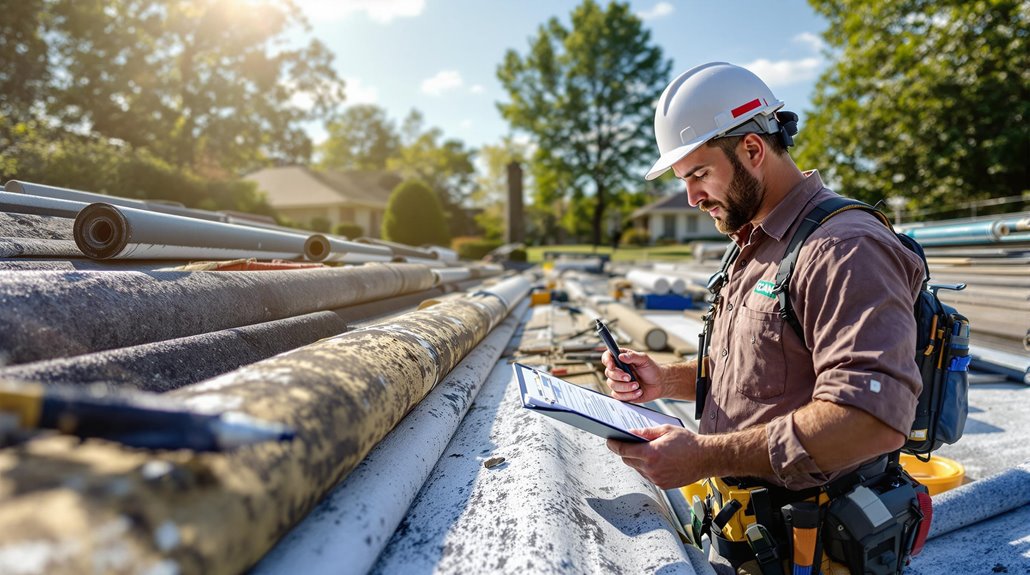
The Public Claims Adjusters Network (PCAN) represents a specialized coalition of licensed insurance claim professionals who advocate exclusively for policyholders.
These public adjusters operate independently from insurance companies, managing the entire claims process from initial filing through final settlement negotiations.
PCAN members provide thorough claim representation services, including detailed damage assessments, detailed cost estimations, and policy interpretation.
They handle all documentation requirements and communications with insurance carriers, ensuring maximum coverage benefits for their clients.
Operating under strict state regulations and licensing requirements, PCAN adjusters typically charge a percentage of the final settlement.
Their expertise in property damage evaluation and insurance policy analysis helps expedite claims while securing fair settlements, reducing the burden on property owners during the claims process.
Frequently Asked Questions
Can I Install Rolled Roofing Over Existing Shingles?
Walking on thin ice, installing rolled roofing over existing shingles creates significant installation challenges. Roofing materials require smooth surfaces for proper adhesion, making direct-to-deck application the recommended method.
How Long Does It Take for Rolled Roofing Repairs to Cure?
Standard cure duration for rolled roofing repairs ranges 24-48 hours, varying with weather impact. Temperature above 50°F and low humidity levels enable ideal curing conditions for proper adhesion.
What Temperature Conditions Are Ideal for Installing Rolled Roofing?
The ideal temperature for rolled roofing installation is above freezing, with mild warmth and low humidity. Installation conditions should feature minimal wind, dry surfaces, and temperatures avoiding extreme heat or cold.
Are DIY Rolled Roofing Repairs Covered by Manufacturer Warranties?
Manufacturer warranties typically exclude DIY repairs unless performed according to strict repair guidelines. Most warranty limitations specify that only certified professionals can perform repairs to maintain coverage validity.
Can Rolled Roofing Be Painted to Match House Colors?
Want to transform your rolled roofing's appearance? While limited color options exist naturally, rolled roofing can be painted using specialized roof coatings, though paint durability varies based on surface preparation and coating quality.
References
- https://www.gsa.gov/real-estate/historic-preservation/historic-preservation-policy-tools/preservation-tools-resources/technical-procedures/minor-repairs-to-asphalt-rollroofing-or-builtup-roofing
- https://mcclellandsroofing.com/blogs/roof-type-and-home-insurance-rates/
- https://colonyroofers.com/learningcenter/roll-roofing-guide-what
- https://blog.theroofstrategist.com/how-roof-insurance-money-works-perfect-way-to-explain-it-to-homeowners/
- https://www.eachimneyandroofing.net/types-rolled-roofing/
- https://www.restorationroofing.com/what-is-rolled-roofing/
- https://simplexroof.com/blog/roofing-materials
- https://www.roof-crafters.com/learn/what-is-rolled-roofing
- https://avenueroofing.com/blog/the-typical-cost-of-a-roof-a-comprehensive-guide/
- https://todayshomeowner.com/roofing/guides/rolled-roofing/
